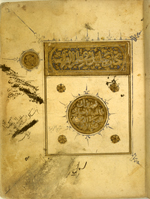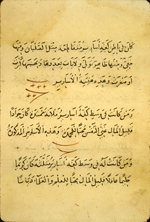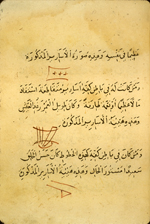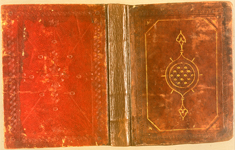Catalogue: Physiognomy
-
 Kitāb al-Jalil fi ‘ilm al-firāsah (MS A 58)
Kitāb al-Jalil fi ‘ilm al-firāsah (MS A 58) - (An Important Book on the Science of Physiognomy)
- حيان فى علم الفراسه حيان
- by Shams al-Dīn Muḥammad ibn Abī Ṭālib al-Dimashqī (d. 1327 / 727 H)
- شمس الدين محمد ابن ابى طالب الدمشقى الانصارى الصوفى
One of the most popular Arabic treatises on physiognomy was that written by Shams al-Dīn al-Dimashqī, who was an imam in the town of Rabwah in Syria. In his treatise on the topic, often titled al-Siyasah fī ‘ilm al-firāsah, he cites seven authorities in the field, each of which he designates with abbreviations: Aristotle (indicated by the emphatic ta'), a Greek authority on the topic named Polemon (whom he designed by the letter nun), the physician al-Rāzī (designated by the letter sad representing the medical encyclopaedia Kitāb al-Mansuri where a chapter on the topic occurs), the theologian Fakhr al-Dīn al-Rāzī (abbreviated ra'), the Spanish mystic Ibn al-‘Arabi (abbreviated ba'), the 8th-9th century theologian and jurist al-Shafi‘i (abbreviated ‘ayn), and a writer whom al-Dimashqi called Aylawus (abbreviated with the letter sin). This latter figure could be a Greek physician named Aelius, but is more likely a garbled reference to Hippocrates, for several Hippocratic writings were quite influential in later physiognomic thought because they employed physiognomic indicators. For example, the Hippocratic tract on prognosis and signs of death used physical characteristics as guides - it was a bad sign if the nose became sharp and the eye sunken, or if the fingernails were a greenish color, then death might be expected soon.
The treatise by al-Dimashqī is preserved today in at least sixteen copies. For other copies, see GAL vol. 2, p. 130 (161) and GAL-S, vol. 2, p. 161; and Ullmann, Natur, p. 34 and 130. The NLM copy, though undated, is an early and important copy made in Mamluk Egypt.
The text has been published twice: first in a 19th-century uncritical edition, Al-Firāsah li-ajil al-siyasah (Cairo, 1882), and then more recently in an edition employing several manuscripts (though not the one at NLM): Shams al-Dīn Muḥammad ibn Abī Ṭālib al-Dimashqī, al-Siyasah fi ‘ilm al-farāsah, edited by Muḥammad ibn al-Sufi (Cairo: Dar Zahid al-Qudsi, 1983).
Kitāb al-Jalil fi ‘ilm al-firāsah (MS A 58)
Illustrations
The illuminated opening for an undated copy made in Mamluk Egypt of the popular treatise on physiognomy written by Shams al-Dīn al-Dimashqī (d. 1327 / 727). The copy is undated and unsigned. The appearance of the paper, script, ink, and illuminated headpiece on the title page suggest a dating of about 1400 and a place of production in Mamluk Egypt.
Illustrations of the lines on the hand and palm used in physiognomy. From an early and important copy of the popular treatise on physiognomy written by Shams al-Dīn al-Dimashqī (d. 1327 / 727). The copy is undated and unsigned. The appearance of the paper, script, ink, and illuminated headpiece on the title page suggest a dating of about 1400 and a place of production in Mamluk Egypt.
The front and back covers of this binding are taken from different manuscripts. The front or upper cover is a 15th-century Egyptian/Syrian binding of brown leather over pasteboards. The frame is formed of blind-tooled fillets either side of a running pattern made of impressions of a rectangular stamp with a vegetal design. The inner panel is defined by fillets, one of which is painted gold; the decorative devices in the corners are also painted gold. At the center of the inner panel is a circular medallion filled with interlocking strapwork, highlighted with gold paint. The circular medallion has a gold-painted outline with points in ogival form passing through a bar-shaped vestigal ring to end in finials, all outlined in gold. The back cover is of red leather over pasteboards. At the center is a symmetrical vegetal design, blind stamped, surrounded by smaller S-shaped stamps and flower-heads aligned along blind-tooled lines markings the horizontal, the vertical, and the diagonals. There is a wide frame formed of three blind-tooled fillets either side of a row of S-stamps, with small flower-heads at the corners.
Physical Description
Arabic. 92 folios (fols. 2a-93b). Dimensions: 21 x 15.7 (text area 12.8 x 11); 9 lines per page. The title appears on the illuminated title page (fol. 2a). The treatise is also known as al-Siyasah fi ‘ilm al-firasah, or al-Firāsah li-ajl al-siyasah, or Ahkam al-āsah. The author's name is given in text (fol. 2b lines 5-6) and on title page (fol. 2a) as Muḥammad ibn Abī Ṭālibal-Anṣārī al-ṣūfī al-Dimashqī, a shaykh of Rabwa in Syria.
The copy is undated and unsigned. The appearance of the paper, script, ink, and illuminated headpiece on the title page suggest a dating of about 1400 and a place of production in Mamluk Egypt.
The copy is complete. The text is written in a large naskh, fully vocalized. Throughout the text the word al-firasah (physiognomy) is voweled as al-farasah ('horsemanship'). It is written in black ink with headings in brown-red. There are no catchwords.
There is an illuminated headpiece on the title page (fol. 2a), executed in a manner typical of Mamluk workmanship, with gold, black ink, and blue and white opaque paint; a rectangular band carries the name of the treatise, while the author's name is in the large shamsah. There are illustrations of the lines on the hand and the palm on fols. 86b-88b and 89b.
There are some marginalia in later hands, some of it interlinear.
The beige, lightly-glossed, paper is thick and nearly opaque. Many folios have neither laid nor chain lines visible, but some folios have visible laid lines and chain lines in alternating groups of 2's and 3's. The top of the volume is severely water stained, and elsewhere there is some damp-staining and soiling through thumbing.
The volume consists of 94 leaves. Fol. 1 is blank except for some penciled notes including the date 984 (= 1576-7); fol. 94 is blank except for a small Turkish notes mentioning the dates 984 and 988 (= 1576-7 and 1580-1).
Binding
The front and back covers of this binding are taken from different manuscripts. The front or upper cover is a 15th-century Egyptian/Syrian binding of brown leather over pasteboards. The frame is formed of blind-tooled fillets either side of a running pattern made of impressions of a rectangular stamp with a vegetal design. The inner panel is defined by fillets, one of which is painted gold; the decorative devices in the corners are also painted gold. At the center of the inner panel is a circular medallion filled with interlocking strapwork, highlighted with gold paint. The circular medallion has a gold painted outline with points in ogival form passing through a bar-shaped vestigal ring to end in finials, all outlined in gold. It has a block-pressed leather doublure.
The lower cover is made of red leather over pasteboards. At the center is a symmetrical vegetal design, blind stamped, surrounded by smaller S-shaped stamps and flower-heads aligned along blind-tooled lines markings the horizontal, the vertical, and the diagonals. There is a wide frame formed of three blind-tooled fillets either side of a row of S-stamps, with small flower-heads at the corners. There are paper pastedowns on the lower cover. There are modern endpapers. On fol. 1a there are traces of an envelope flap from an earlier binding.
Provenance
There are various owners' notes, nearly all defaced. One of the notes on fol. 2a is dated 1212 [1797-8] ; others (undated) are on fol. 93b. Fol. 94 is blank except for a small Turkish note mentioning the dates 984 and 988 [1576-7 and 1580-1.
The volume was purchased in 1941 by the Army Medical Library from A. S. Yahuda (ELS 1668).
References
Schullian/Sommer, Cat. of incun. & MSS., 1950, A58, p. 316.
NLM Microfilm Reel: FILM 48-123 no. 5














